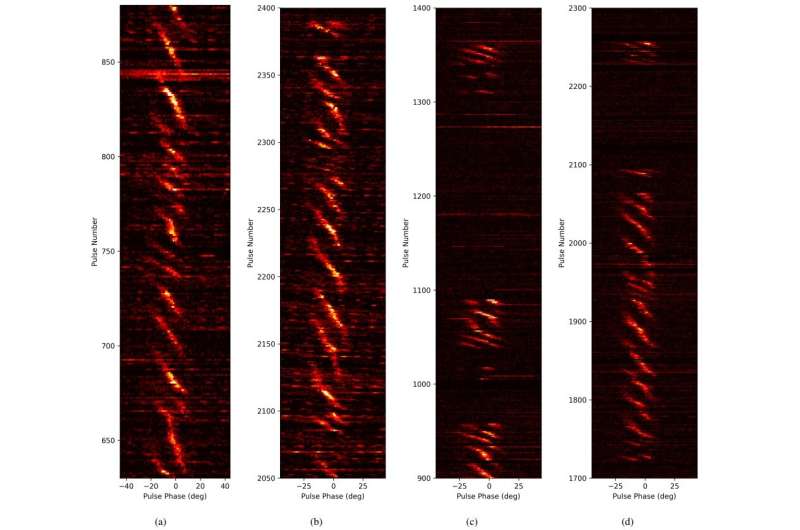July 15, 2023 report
This article has been reviewed according to Science X's editorial process and policies. Editors have highlighted the following attributes while ensuring the content's credibility:
fact-checked
preprint
trusted source
proofread
Astronomers observe subpulse drifting and nulling of pulsar PSR J0026–1955

Using the upgraded Giant Meterwave Radio Telescope (uGMRT), astronomers from India and Australia have performed radio observations of a pulsar known as PSR J0026–1955. Results of the observational campaign, published July 5 on the preprint server arXiv, shed more light on the subpulse drifting and nulling behavior of this pulsar.
Pulsars are highly magnetized, rotating neutron stars emitting a beam of electromagnetic radiation. They are usually detected in the form of short bursts of radio emission; however, some of them are also observed via optical, X-ray and gamma-ray telescopes.
Radio emission from pulsars exhibits a variety of phenomena, including subpulse drifting, nulling, or mode changing. In the case of subpulse drifting, radio emission from a pulsar appears to drift in spin phase within the main pulse profile. When it comes to nulling, the emission from a pulsar ceases abruptly from a few to hundreds of pulse periods before it is restored.
Discovered in 2018, PSR J0026–1955 is a Galactic pulsar with a spin period of approximately 1.306 seconds and dispersion measure of 20.81 pc/cm3. It has a spin-down luminosity of 23 nonillion erg/s, surface magnetic field strength of 770 billion Gauss, and its characteristic age is estimated to be some 47 million years.
Subpulse drifting and nulling of radio emission in PSR J0026–1955 was first reported in 2022 using the Murchison Widefield Array (MWA). Now, a team of astronomers led by Parul Janagal of the Indian Institute of Technology Indore, India, decided to take a closer look at this behavior.
"In this study, we present a detailed investigation of subpulse drifting and nulling exhibited by J0026–1955, with new observations obtained using the upgraded Giant Metrewave Radio Telescope (uGMRT) at 300–500 MHz," the researchers wrote in the paper.
In general, the observations revealed that PSR J0026–1955 experiences unusual drifting behavior, with both evolutionary and non-evolutionary drift rates. Two distinct subpulse drifting modes have been identified, designated A and B. The mode A has been further sub-categorized into A0, A1, and A2, depending upon the drift rate evolutionary behavior.
Furthermore, the study found that PSR J0026–1955 exhibits short- and long-duration nulls, with an estimated nulling fraction of about 58%, therefore much lower than reported in MWA observations. The authors of the paper assume that this discrepancy could be due to differences in the lengths of observations, or a shallow spectral index component, or a frequency dependence of nulling.
The observations also found evidence of subpulse memory across nulls in PSR J0026–1955.
"In multiple instances, we have found the possibility of 'drift rate' and 'subpulse phase' memory across nulls. We believe that there could be an uninterrupted stable discharge in the polar gap during the null, which is not observed due to the absence of a dominant coherence mechanism or a partially screened gap making the generation of detectable radio emission difficult," the researchers explained.
Summing up the results, the authors of the study underlined that PSR J0026–1955 represents a small fraction of pulsars exhibiting subpulse drifting, nulling, mode changing and drift rate evolution.
More information: Parul Janagal et al, PSR J0026-1955: A curious case of evolutionary subpulse drifting and nulling, arXiv (2023). DOI: 10.48550/arxiv.2307.02393
Journal information: arXiv
© 2023 Science X Network





















